-
 Bitcoin
Bitcoin $105,953.9980
3.06% -
 Ethereum
Ethereum $2,445.3292
6.68% -
 Tether USDt
Tether USDt $1.0006
-0.03% -
 XRP
XRP $2.1968
7.03% -
 BNB
BNB $643.2903
2.13% -
 Solana
Solana $144.2799
3.82% -
 USDC
USDC $1.0000
-0.03% -
 TRON
TRON $0.2739
0.49% -
 Dogecoin
Dogecoin $0.1642
4.47% -
 Cardano
Cardano $0.5834
5.49% -
 Hyperliquid
Hyperliquid $38.0741
2.80% -
 Sui
Sui $2.7741
7.56% -
 Chainlink
Chainlink $13.4107
11.26% -
 Bitcoin Cash
Bitcoin Cash $450.4828
-0.61% -
 UNUS SED LEO
UNUS SED LEO $9.1301
0.64% -
 Stellar
Stellar $0.2476
5.49% -
 Avalanche
Avalanche $18.0637
5.09% -
 Toncoin
Toncoin $2.9066
2.43% -
 Shiba Inu
Shiba Inu $0.0...01160
4.01% -
 Hedera
Hedera $0.1527
8.00% -
 Litecoin
Litecoin $84.6122
2.37% -
 Monero
Monero $317.6076
5.76% -
 Ethena USDe
Ethena USDe $1.0008
0.02% -
 Polkadot
Polkadot $3.4519
5.27% -
 Dai
Dai $1.0000
-0.03% -
 Bitget Token
Bitget Token $4.2835
5.62% -
 Uniswap
Uniswap $7.0443
9.78% -
 Pepe
Pepe $0.0...09964
7.41% -
 Pi
Pi $0.5391
4.64% -
 Aave
Aave $264.1743
11.26%
What does the Bollinger Bands narrowing and then suddenly expanding imply?
Bollinger Bands narrowing signals low volatility and potential breakout, while sudden expansion indicates rising volatility and possible trend continuation or reversal in crypto markets.
Jun 24, 2025 at 05:56 pm
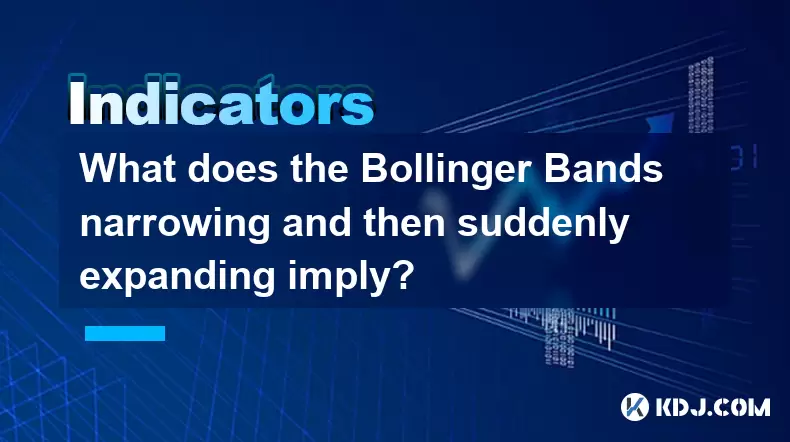
Understanding Bollinger Bands in Cryptocurrency Trading
Bollinger Bands, a popular technical analysis tool, are widely used in cryptocurrency trading to assess price volatility and potential trend reversals. The indicator consists of three lines: a Simple Moving Average (SMA) in the middle, typically set at 20 periods, with two outer bands that represent standard deviations above and below the SMA. These bands dynamically adjust based on recent price action.
In the context of digital asset markets, where volatility is often high and unpredictable, understanding the behavior of Bollinger Bands narrowing and then suddenly expanding becomes crucial for traders aiming to capture momentum or avoid false breakouts.
Important Note: Bollinger Bands do not predict price direction directly but rather highlight changes in volatility which may precede significant moves.
What Does It Mean When Bollinger Bands Narrow?
When the distance between the upper and lower Bollinger Bands decreases, it indicates a period of low volatility. This contraction phase often occurs after extended trends or during consolidation phases where the market is "deciding" its next move.
This narrowing can be interpreted as a coiling spring effect, where pressure builds up within the market structure, suggesting that a breakout may soon occur. In crypto markets, this phenomenon is frequently observed before major news events, regulatory updates, or macroeconomic shifts.
- The 20-period SMA remains relatively flat during this phase
- Price action gravitates toward the middle band
- Traders should monitor volume levels closely during these periods
The key takeaway here is that a narrowing of Bollinger Bands does not signal a trade by itself—it simply suggests that a significant move is imminent.
Why Do Bollinger Bands Suddenly Expand After a Period of Contraction?
Following a contraction, a sudden expansion of Bollinger Bands signifies an abrupt increase in market volatility. This expansion usually coincides with a sharp price movement—either upward or downward—and is often triggered by external catalysts such as:
- Unexpected regulatory announcements affecting crypto exchanges
- Major whale movements influencing liquidity
- Integration of blockchain protocols into mainstream finance
From a technical standpoint, when price breaks out of the tight range formed during the contraction, it causes the standard deviation calculations to widen, hence pushing the bands apart. This widening visually reinforces that a new trend may be forming or that a strong reaction has occurred.
It's important to note that false breakouts can also cause temporary expansions, especially in low-liquidity altcoin pairs. Therefore, confirming the move with other indicators like RSI or MACD is highly recommended.
How to Interpret the Implications of a Sudden Expansion After a Narrowing?
The combination of narrowing followed by sudden expansion in Bollinger Bands can offer valuable insights for traders:
- Continuation Pattern: If the expansion aligns with the previous trend direction, it could signal a continuation of that trend.
- Reversal Signal: A sharp expansion in the opposite direction of the prevailing trend might indicate a reversal.
- Breakout Confirmation: A valid breakout beyond the bands often results in a powerful move, especially if supported by increased volume.
For example, during Bitcoin’s sideways consolidation in mid-2023, a sudden spike following ETF-related news caused the Bollinger Bands to rapidly expand, signaling the start of a bullish run. Traders who recognized this pattern early were able to position accordingly.
However, one must remain cautious, as not all expansions lead to sustained trends. Sometimes, the market whipsaws, causing confusion and losses for those entering too early.
Practical Steps to Trade Using Bollinger Band Narrowing and Expansion Patterns
To effectively utilize this pattern in your trading strategy, follow these steps:
- Identify the contraction phase: Use the Bollinger Band width indicator or manually observe decreasing band separation.
- Monitor volume and order book depth: A drop in volume during contraction often precedes a strong move once volume returns.
- Look for catalysts: Check upcoming events or recent developments that could trigger a breakout.
- Wait for a confirmed breakout: Enter only after price closes outside the band with supporting candlestick patterns.
- Set stop-loss orders: Place stops just inside the band to protect against false signals.
It’s essential to combine this approach with additional tools like Fibonacci retracements or moving average crossovers to filter out noise and improve accuracy.
Frequently Asked Questions
Q: Can Bollinger Bands narrowing/expansion be used on any time frame?
Yes, the pattern applies across different time frames. However, higher time frames (like 4-hour or daily) tend to provide more reliable signals than shorter ones due to reduced noise.
Q: Is it possible for Bollinger Bands to stay narrow indefinitely?
No, the nature of cryptocurrency markets ensures that volatility will eventually return. Prolonged narrowing usually ends with a significant move, even if it takes days or weeks.
Q: What is the best setting for Bollinger Bands when watching for narrowing and expansion patterns?
The default settings (20-period SMA and 2 standard deviations) are generally effective. Some traders adjust the standard deviation to 1.5 or 2.5 depending on the asset's volatility profile.
Q: Should I always take action when I see Bollinger Bands expanding after narrowing?
Not necessarily. Always wait for confirmation through price action and volume before making a trade decision.
Disclaimer:info@kdj.com
The information provided is not trading advice. kdj.com does not assume any responsibility for any investments made based on the information provided in this article. Cryptocurrencies are highly volatile and it is highly recommended that you invest with caution after thorough research!
If you believe that the content used on this website infringes your copyright, please contact us immediately (info@kdj.com) and we will delete it promptly.
- Cryptocurrencies: Chart-Breaking Buys Beyond the Hype
- 2025-06-25 04:45:12
- Navigating Crypto Volatility: UNI Price, SUI Token, and the Rise of Unstaked
- 2025-06-25 04:45:12
- Bitcoin, Ethereum, and Geopolitical Tensions: Navigating the Iran-Israel Ceasefire
- 2025-06-25 05:05:13
- JPMorgan, Blockchain, and JPMD Token: A Quantum Leap for On-Chain Finance?
- 2025-06-25 05:05:13
- Chainlink, Mastercard, and Crypto Adoption: Bridging the Gap to Mainstream DeFi
- 2025-06-25 05:44:12
- Hedera Price: Trend Reversal or Downtrend Continuation?
- 2025-06-25 06:05:12
Related knowledge
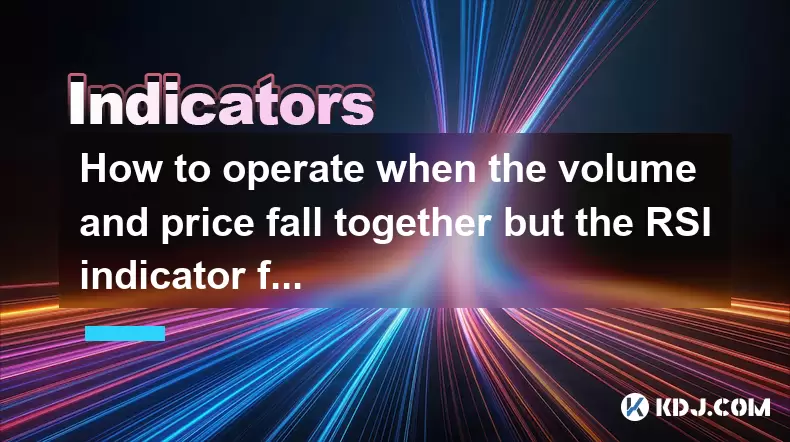
How to operate when the volume and price fall together but the RSI indicator forms a bottom divergence?
Jun 25,2025 at 04:29am
Understanding the Concept of RSI Bottom DivergenceWhen analyzing cryptocurrency price charts, traders often rely on technical indicators to spot potential reversals. One such signal is a bottom divergence in the Relative Strength Index (RSI). This occurs when the price makes a new low, but the RSI does not confirm that low and instead forms a higher low...
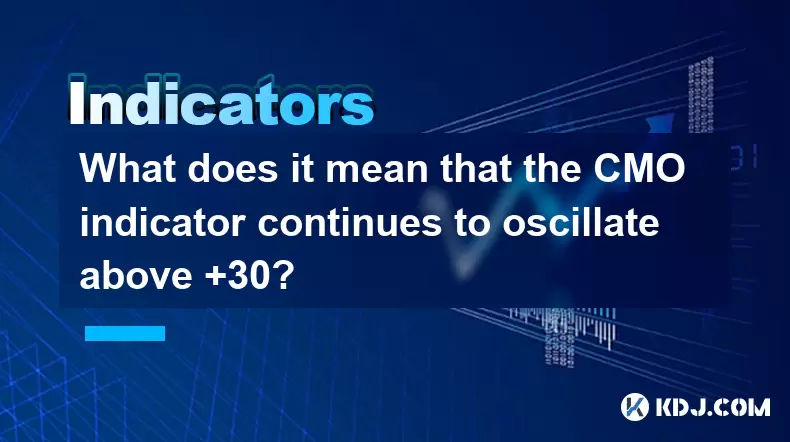
What does it mean that the CMO indicator continues to oscillate above +30?
Jun 25,2025 at 03:29am
Understanding the CMO IndicatorThe Chande Momentum Oscillator (CMO) is a technical analysis tool developed by Tushar Chande to measure momentum in financial markets. In cryptocurrency trading, the CMO helps traders identify overbought or oversold conditions and potential trend reversals. The oscillator ranges from -100 to +100, with values above zero in...

What does it mean that the ATR indicator suddenly doubles after hitting a new low this year?
Jun 24,2025 at 11:57pm
Understanding the ATR IndicatorThe Average True Range (ATR) is a technical analysis indicator used to measure market volatility. Developed by J. Welles Wilder, ATR calculates the average price range between a security’s high and low over a specific period—typically 14 periods. It does not indicate the direction of price movement but rather how volatile ...
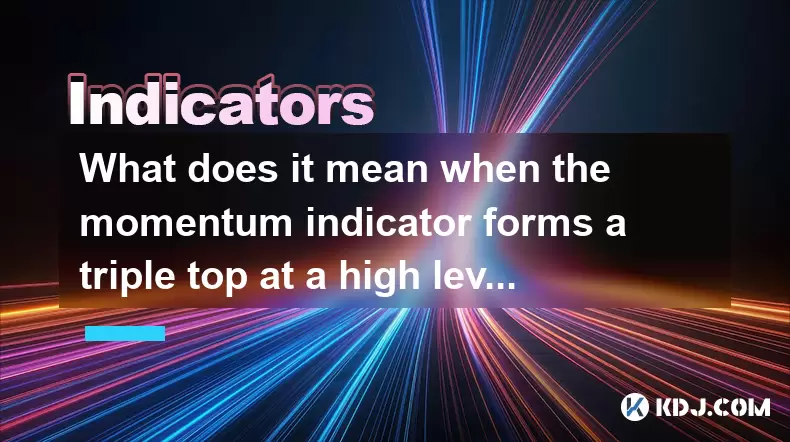
What does it mean when the momentum indicator forms a triple top at a high level?
Jun 25,2025 at 03:15am
Understanding the Momentum Indicator in Cryptocurrency TradingThe momentum indicator is a widely used technical analysis tool that measures the rate of change in price movements over a specified period. In cryptocurrency trading, where volatility is high and trends can reverse rapidly, this indicator helps traders identify potential trend reversals or c...

What does the divergence between the volatility indicator and the price indicate?
Jun 25,2025 at 06:07am
Understanding the Volatility IndicatorThe volatility indicator is a technical analysis tool used to measure the rate and magnitude of price movements in financial markets, including cryptocurrencies. It helps traders assess whether a market is experiencing high or low volatility, which can influence trading decisions. Common types of volatility indicato...
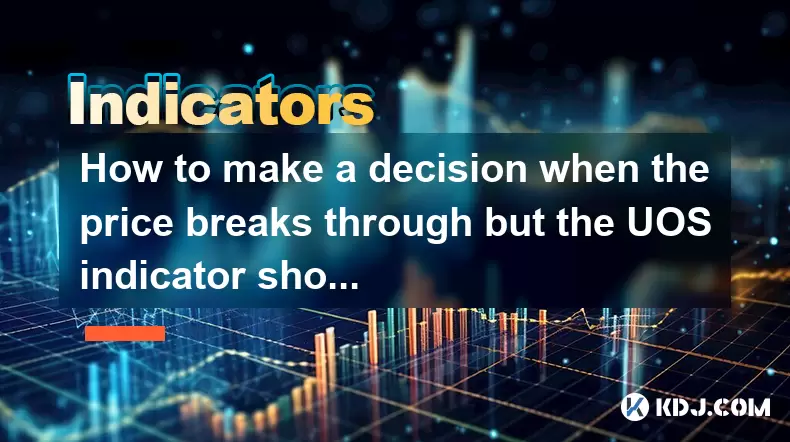
How to make a decision when the price breaks through but the UOS indicator shows a top divergence?
Jun 24,2025 at 11:42pm
Understanding the UOS Indicator and Price BreakthroughsThe Ultimate Oscillator (UOS) is a momentum oscillator that combines multiple timeframes to provide a more accurate picture of market momentum. When traders observe a price breakthrough — where the price moves above a key resistance level — but the UOS indicator shows a top divergence, it creates a ...

How to operate when the volume and price fall together but the RSI indicator forms a bottom divergence?
Jun 25,2025 at 04:29am
Understanding the Concept of RSI Bottom DivergenceWhen analyzing cryptocurrency price charts, traders often rely on technical indicators to spot potential reversals. One such signal is a bottom divergence in the Relative Strength Index (RSI). This occurs when the price makes a new low, but the RSI does not confirm that low and instead forms a higher low...

What does it mean that the CMO indicator continues to oscillate above +30?
Jun 25,2025 at 03:29am
Understanding the CMO IndicatorThe Chande Momentum Oscillator (CMO) is a technical analysis tool developed by Tushar Chande to measure momentum in financial markets. In cryptocurrency trading, the CMO helps traders identify overbought or oversold conditions and potential trend reversals. The oscillator ranges from -100 to +100, with values above zero in...

What does it mean that the ATR indicator suddenly doubles after hitting a new low this year?
Jun 24,2025 at 11:57pm
Understanding the ATR IndicatorThe Average True Range (ATR) is a technical analysis indicator used to measure market volatility. Developed by J. Welles Wilder, ATR calculates the average price range between a security’s high and low over a specific period—typically 14 periods. It does not indicate the direction of price movement but rather how volatile ...

What does it mean when the momentum indicator forms a triple top at a high level?
Jun 25,2025 at 03:15am
Understanding the Momentum Indicator in Cryptocurrency TradingThe momentum indicator is a widely used technical analysis tool that measures the rate of change in price movements over a specified period. In cryptocurrency trading, where volatility is high and trends can reverse rapidly, this indicator helps traders identify potential trend reversals or c...

What does the divergence between the volatility indicator and the price indicate?
Jun 25,2025 at 06:07am
Understanding the Volatility IndicatorThe volatility indicator is a technical analysis tool used to measure the rate and magnitude of price movements in financial markets, including cryptocurrencies. It helps traders assess whether a market is experiencing high or low volatility, which can influence trading decisions. Common types of volatility indicato...

How to make a decision when the price breaks through but the UOS indicator shows a top divergence?
Jun 24,2025 at 11:42pm
Understanding the UOS Indicator and Price BreakthroughsThe Ultimate Oscillator (UOS) is a momentum oscillator that combines multiple timeframes to provide a more accurate picture of market momentum. When traders observe a price breakthrough — where the price moves above a key resistance level — but the UOS indicator shows a top divergence, it creates a ...
See all articles
























































































